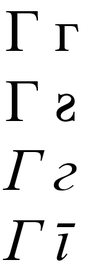Ge (Cyrillic)
This articleneeds additional citations forverification.(February 2007) |

Ge,ghe,orhe(Г г; italics:Гг) is a letter of theCyrillic script.Most commonly, it represents thevoiced velar plosive/ɡ/,like⟨g⟩in "gift ", or thevoiced glottal fricative[ɦ],like⟨h⟩in "heft ". It is generally romanized using the Latin lettergorh,depending on the source language.
History
[edit]The Cyrillic letter ge was derived directly from the Greek letterGamma(Γ) inuncial script.
In theEarly Cyrillic Alpha bet,its name wasглаголь(glagol'), meaning "speak".
In theCyrillic numeral system,it had a numerical value of 3.
Usage in Slavic languages
[edit]
Russian/Serbian normal font;
Bulgarian Cyrillic;
Russian/Bulgarian italic;
Serbian italic
Belarusian, Rusyn, and Ukrainian
[edit]From these three languages, the letter is romanized withh.Its name ishein Belarusian and Ukrainian, andhyin Rusyn.
InBelarusian(like in Southern Russian), the letter corresponds to thevelar fricative/ɣ/[1]and its soft counterpart/ɣʲ/.
InUkrainianandRusyn,it represents avoiced glottal fricative[ɦ],[1]abreathy voicedcounterpart of the English[h].
InUkrainianandRusyn,a voiced velar plosive/ɡ/is written with theCyrillic letter ghe with upturn(Ґ ґ). In Belarusian, the official orthography uses г for both/ɣ/and/ɡ/(which is rare), although inTaraškievicaghe with upturn is optionally used for/ɡ/.Ґ is transliterated withG.
In all three languages' historical ancestorRuthenian,the sound/ɡ/was also represented by the digraph кг.
Russian
[edit]In standardRussian,ghe represents thevoiced velar plosive/ɡ/but is devoiced to[k]word-finally or before a voiceless consonant. It represents/ɡʲ/before apalatalizingvowel. In theSouthern Russiandialect, the sound becomes thevelar fricative/ɣ/.Sometimes, the sound is theglottal fricative/ɦ/in the regions bordering Belarus and Ukraine.
It is acceptable, for some people, to pronounce certain Russian words with[ɣ](sometimes referred to asUkrainian Ge):Бог, богатый, благо, Господь(Bog, bogatyj, blago, Gospod’). The sound is normally considered nonstandard or dialectal in Russian and is avoided by educated Russian speakers.Бог(Bog,"God" ) is always pronounced[box]in thenominative case.[1]
In the Russian nominal genitive ending-ого, -его,ghe represents[v],including in the wordсегодня( "today", fromсего дня).
It represents a voiceless[x](not[k]) in front ofkain two Russian words, namely,мягкийandлёгкий,and their derivatives.
The Latin letterhof words of Latin, Greek, English or German origin is usually transliterated into Russian with ghe rather thankha:hero→герой,hamburger→гамбургер,Haydn→Гайдн.That can occasionally cause ambiguity, as for example EnglishHarryandGary/Garrywould be spelled the same in Russian, e.g.Гарри Поттер). The reasons for using ghe to writehinclude the fact that ghe is used forhin Ukrainian, Belarusian and some Russian dialects, along with the perception that kha sounds too harsh. Nevertheless, in newer loanwords (especially from English), kha is often used.[citation needed]
South Slavic
[edit]In standardSerbian,Bosnian,Montenegrin,BulgarianandMacedonianthe letter ghe represents avoiced velar plosive/ɡ/.But in Bulgarian and Macedonian it is devoiced to[k]word-finally or before a voiceless consonant.
Usage in non-Slavic languages
[edit]In many non-Slavic languages it can represent both/ɡ/and/ʁ~ɣ/(the latter mostly inTurkicand someFinno-Ugric languages).
InOssetian,anIndo-Iranian languagespoken in theCaucasus,⟨г⟩ represents the voiced velar stop/ɡ/.However, the digraph ⟨гъ⟩ represents thevoiced uvular fricative/ʁ/.
Related letters and other similar characters
[edit]- Γ γ:Greek letter Gamma
- G g:Latin letter G
- H h:Latin letter H,romanized as in Belarusian, Ukrainian, and Rusyn
- Z z:Latin letter Z,alternative form of italicized Cyrillic Г (ge)
- Ґ ґ:Cyrillic letter ghe with upturn,the letterg,named ge in Ukrainian
- Ѓ ѓ:Cyrillic letter Gje
- Ғ ғ:Cyrillic letter Ghayn
- R r:Latin letter R (lowercase)
- ₴:Ukrainian hryvnia(Currency sign)
Computing codes
[edit]| Preview | Г | г | ||
|---|---|---|---|---|
| Unicode name | CYRILLIC CAPITAL LETTER GHE | CYRILLIC SMALL LETTER GHE | ||
| Encodings | decimal | hex | dec | hex |
| Unicode | 1043 | U+0413 | 1075 | U+0433 |
| UTF-8 | 208 147 | D0 93 | 208 179 | D0 B3 |
| Numeric character reference | Г |
Г |
г |
г |
| Named character reference | Г | г | ||
| KOI8-RandKOI8-U | 231 | E7 | 199 | C7 |
| CP 855 | 173 | AD | 172 | AC |
| Windows-1251 | 195 | C3 | 227 | E3 |
| ISO-8859-5 | 179 | B3 | 211 | D3 |
| Mac Cyrillic | 131 | 83 | 227 | E3 |
Cultural references
[edit]InRussian Empirethe name of the letter,glagol'was an informal reference to the Γ-shapedgallows:
- Кругом пустыня, дичь и голь,
- А в стороне торчит глаголь,
- И на глаголе том два тела
- Висят. Закаркав, отлетела
- Ватага чёрная ворон,...
- [All around there is desert, game and bareness... And aglagol'sticks out on the side, And on thatglagol'two bodies hang. The gang of black crows croaked and flew off..]
- Alexander Pushkin,1836[2]
See also
[edit]- Gamma,the Greek letter Γ
References
[edit]- ^abcЗвуки на месте буквы г[Sounds in place of the letter г].Scholarly Dialectical Atlas(in Russian). map 14.
- ^Альфонс садится на коня…

